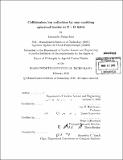Collisionless ion collection by non-emitting spherical bodies in E x B fields
Author(s)
Patacchini, Leonardo
DownloadFull printable version (26.30Mb)
Other Contributors
Massachusetts Institute of Technology. Dept. of Nuclear Science and Engineering.
Advisor
Ian H. Hutchinson.
Terms of use
Metadata
Show full item recordAbstract
The three-dimensional interaction of a magnetized, collisionless flowing plasma with a non-emitting conducting sphere is solved in the entire range of physically allowed parameters, in the ion-collecting regime. This can be considered as the "spherical Mach probe" problem, establishing how the ion flux to the surface varies with orientation and external velocity; the study is however of broader interest, as the sphere can also be seen as a dust particle or any ionospheric body. The core tool developed for this study is the fully parallelized (particle + field solver) Particle-In-Cell code SCEPTIC3D, three-dimensional evolution of SCEPTIC, accounting for the full ion distribution function and Boltzmann electrons. Investigations are first carried out in the quasineutral limit. Results include a report of ion current dependence on the external plasma parameters, as well as a theoretical calibration for transverse Mach probes with four electrodes oriented at 450 to the magnetic field in a plane of flow and magnetic field, valid for arbitrary temperature and ion magnetization. The analysis is preceded by an independent semi-analytic treatment of strongly magnetized ion collection by oblique surfaces, successfully validating SCEPTIC3D's behaviour. (cont.) The finite shielding length regime is more complex, and an important transition in plasma structure occurs when the Debye length goes over the average ion Larmor radius. Studies of ion collection show that the ion current can exceed the (unmagnetized) OML limit at weak magnetization, and the Mach probe calibration method proposed in the context of quasineutral plasmas holds up to Debye lengths equal to about 10% of the probe radius. A further analysis consists in calculating the force exerted by the flow on spherical dust. In short Debye length plasmas a strong drag component antiparallel to the convective electric field forms, causing the dust to spin faster than what predicted by its Larmor frequency. At intermediate and large Debye length the ion-drag in the direction of transverse flow is found to reverse in subsonic conditions, but the internal Laplace force appears to be positive, and larger in magnitude than the negative ion-drag.
Description
Thesis (Ph. D.)--Massachusetts Institute of Technology, Dept. of Nuclear Science and Engineering, 2010. Cataloged from PDF version of thesis. Includes bibliographical references (p. 211-216).
Date issued
2010Department
Massachusetts Institute of Technology. Department of Nuclear Science and EngineeringPublisher
Massachusetts Institute of Technology
Keywords
Nuclear Science and Engineering.